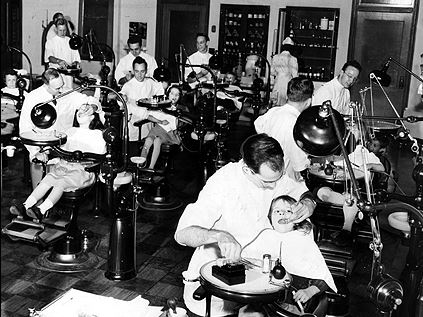
Dentists work with patients, 1945. Image from Star Tribune archives.
Dentistry in 1945 looked nothing like it does today – and this fascinating and somewhat prophetic 1945 Star Tribune article is proof. In 1945, the then Star Journal (today the Star Tribune) story about the University of Minnesota School of Dentistry proved to be a very accurate predictor of what was to come in the industry. The fact that it so perfectly predicted the future of dentistry – including something most in the industry consider fundamental today, such as how dental caries (cavities) occur and the importance of fluoride in caries prevention – demonstrates Minnesota’s progressive nature and the remarkable asset we have in the U of M School of Dentistry.
“Sugar and its Secretions”
Sugar found in the foods that we eat not only give our bodies energy, they also keep the bacteria in our mouths alive, an idea that was very novel in 1945:
“Dental scientists are no longer baffled by what causes tooth decay. They are pretty sure the culprit is sugar. Crawford is so confident of this finding that he will undertake to stop tooth decay in any child by the simple expedient of putting it on a sugar-free diet for 10 days or two weeks. Decay seems to be caused by excretions of bacteria, which live on fermented sugar. Chief of these is the lactobacillus acidophilus. When the sugar is removed, the organism dies. Even after the child is put back on a moderate sugar diet, Crawford said, the bacteria do not return in large numbers.”
The excretions of bacteria that the author writes about is actually the acid that is produced when bacterial plaque is mixed with sugar from the foods we eat. A bit interesting that the article uses the pronoun “it” when talking about the child, but moving on.
Fluoride
The Centers for Disease Control and Prevention (CDC) recognizes the addition of fluoride into our water systems as one of the 10 Great Public Health Achievements of the 20th century, something that was just beginning to gain momentum when the article was written:
“Dental scientists are now hot on the trail of something else which seems to have a lot to do with good or bad teeth. This is the chemical fluorine. It is used to etch glass. It is also employed as an insecticide. It also has the property, when it enters into the building of teeth, of making them resistant to decay.”
Other achievements that the CDC recognizes in the list include vaccination, motor vehicle safety, safer workplaces, control of infectious diseases, decline in deaths from coronary heart disease and stroke, safer and healthier foods, healthier mothers and babies, family planning and recognition of tobacco use as a health hazard.
Ortho boom
Another interesting trend that the article discussed was the orthodontic (braces) movement that was just gaining steam at the time:
“Both the mandible and maxillary are shrinking while the teeth aren’t, at least to the same degree, so that a man’s teeth today are often too big and too numerous for his jaws, and erupt in every which way. As mankind became daintier and daintier in his habits the jaw shrank. In modern times, this degenerative process has brought into being the science of orthodontics, the technique of straightening crooked teeth – another way modern dentistry has found to combat nature.”
While placing braces on teenagers’ teeth is much more common in the United States compared to other developed countries, it has proved to be a powerful tool in improving the form, function and appearance of many of our smiles!






